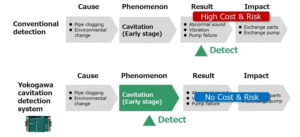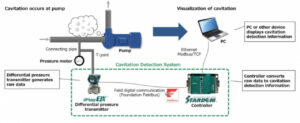In Part One of this article, you learned how cavitation occurs. In the second part, you will get to know how cavitation can be detected in an early stage.
To protect pumps more effectively, therefore, they should be monitored. Unfortunately, even portable vibration meters are not capable of detecting cavitation in its early stages, as no general indications exist for early detection. On the other hand, even tiny changes in the pressure profile are a pointer to cavitation inducing conditions. One of the most efficient monitoring strategies – and one which yields clear and reproducible results – is consequently to determine pressure profile variations on the pump’s suction side.
Fig. 2: Yokogawa’s EJX differential pressure transmitter and STARDOM controller enable pump and process operations to be monitored in real time using proprietary technologies. A highly precise differential pressure transmitter equipped with a silicon resonant sensor, which detects even the smallest variations in pressure, is connected to the pump’s suction side. The transmitter sends this data to a downstream control system via a high speed digital communications link.
A data acquisition cycle of 100 milliseconds and a control system with high speed, real-time calculation functionality are necessary to detect cavitation in real time. The control system analyzes the internal, unfiltered pressure values produced by the differential pressure transmitter in order to obtain information on the pressure profiles in both the pump and the attached piping. The raw data is converted into robust information with the aid of special routines in the control system before being passed on to the maintenance personnel. Each control system features an integrated web server that can send information to any device which supports a web browser. This information can be transmitted over the Internet or intranet as well as to a PC using a Modbus device.
Information in real-time
The onset of cavitation conditions is revealed very early by the real-time information, so that appropriate action can be taken in good time: even minuscule pressure changes which are attributable to cavitation events are interpreted by the advanced analytics, meaning the user can be alerted without delay – long before vibration or noise events are discernible. Such information can also be used to troubleshoot problems and search for the causes. The impacts of cavitation, and the damage it inflicts, are directly related to the magnitude of the pressure variations and their evolution over time. By studying the history, maintenance staff can thus identify and categorize critical events while service engineers can implement prevention methods using this data based information.
Summary
Online monitoring is an effective method for detecting the very early onset of cavitation events – before damage occurs. Early detection is a precondition of rapid intervention. There are fewer disruptions to operation while maintenance work and costs are reduced to a minimum.
To ensure that asset values and operations are protected in the long term, it is important to identify and assess the causes. HOW do cavitation conditions develop? WHY does cavitation occur?
An advanced factor analysis supplies the necessary information on process or operational changes which can cause gas bubbles to form in process fluids. Operating and maintenance personnel can take a look at the operating data, to help identify and categorize the causes. Clogged pipes, open valves or changes in the flow rate are just three of the many possible reasons for the formation of gas bubbles. The onset of cavitation is by and large neither visible nor audible. Advanced analytics frequently represent the only option for getting to the bottom of this phenomenon.
The processes taking place in the plant can be verified with the aid of data-based information. Best-fit preventive measures can be put in place to rule out cavitation damage.
Better-qualified maintenance staff
Engineers with extensive experience develop programs to prolong the lifetime of critical, high maintenance plant components. They plan preventive maintenance work with the aim of reducing unplanned outages to a minimum. However, if these experienced service engineers go into retirement, much specialist expertise tends to be lost. Thanks to IIoT and predictive analytical tools, their successors can now have more real-time knowledge at their fingertips. These tools save valuable time – from data mining to the creation of sustainable value. Advanced analytical tools and pressure monitoring systems provide a way to identify early cavitation events and differentiate them from other causes.
These early warnings are crucial for deciding whether a minor repair involving only limited disruptions to production is sufficient or whether there is a risk of total failure and hence significant downtime of units or equipment (Figure 3).

Conclusion
Preventive maintenance uses IIoT to protect and prolong the lifetime of critical components, such as pumps in process plants. Yokogawa’s new preventive monitoring method employs a combination of the highly precise, high speed EJX differential pressure transmitter and the IIoT application as an advanced analytical tool for monitoring and reporting fine pressure anomalies in critical pumps.





